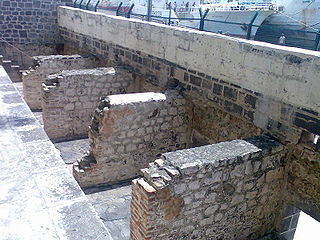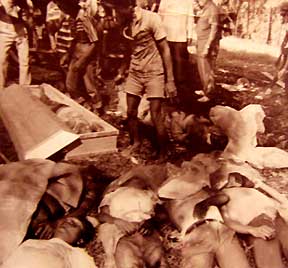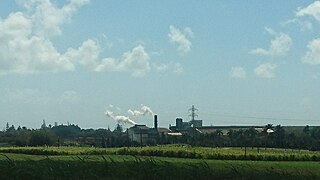
Mauritius, officially the Republic of Mauritius, is an island nation in the Indian Ocean about 2,000 kilometres (1,200 mi) off the southeast coast of the African continent, east of Madagascar. It includes the main island, as well as Rodrigues, Agaléga and St. Brandon. The islands of Mauritius and Rodrigues, along with nearby Réunion, are part of the Mascarene Islands. The capital and largest city, Port Louis, is located on Mauritius, where most of the population is concentrated. The country spans 2,040 square kilometres (790 sq mi) and has an Exclusive Economic Zone covering 2.3 million square kilometres.
The known history of Mauritius begins with its discovery by Arabs and Malays, followed by Europeans and its appearance on maps in the early 16th century. Mauritius was successively colonized by the Netherlands, France and Great Britain, and became independent in 1968.

Seewoosagur Ramgoolam was a Mauritian politician, statesman and philanthropist. He served as the island's first Chief Minister, Prime Minister of Mauritius, and Governor-General.
Emmanuel Anquetil (1885-1946) was a Mauritian trade unionist, and the second leader of the Mauritius Labour Party.
The Hosay massacre took place on 30 October 1884 in San Fernando, Trinidad when the British colonial authorities fired on participants in the annual Hosay procession who had been banned from entering the town.

The Immigration Depot is a building complex located in Port Louis on the Indian Ocean island of Mauritius, the first British colony to receive indentured, or contracted, labour workforce from many countries. From 1849 to 1923, half a million Indian indentured labourers passed through the Immigration Depot, to be transported to plantations throughout the British Empire. The large-scale migration of the labourers left an indelible mark on the societies of many former British colonies, with Indians constituting a substantial proportion of their national populations. In Mauritius alone, 68 percent of the current total population is of Indian ancestry. The Immigration Depot has thus become an important reference point in the history and cultural identity of Mauritius.
The Indian indenture system was a system of indentured servitude, by which more than one million Indians were transported to labour in European colonies, as a substitute for slave labour, following the abolition of the trade in the early 19th century. The system expanded after the abolition of slavery in the British Empire in 1833, in the French colonies in 1848, and in the Dutch Empire in 1863. Indian indentureship lasted till the 1920s. This resulted in the development of a large Indian diaspora in the Caribbean, Natal, Réunion, Mauritius, Sri Lanka, Malaysia, Myanmar, to Fiji, as well as the growth of Indo-Caribbean, Indo-African, Indo-Fijian, Indo-Malaysian, and Indo-Singaporean populations.

The Escalante massacre was an incident on September 20, 1985 in Escalante City, Negros Occidental, Philippines where para-military forces of the government gunned down civilians engaged in a protest-rally in commemoration of the 13th anniversary of the declaration of Martial Law. It is also called Escam - shorthand for "Escalante massacre", and sometimes Bloody Thursday, though the massacre really happened on a Friday.
The British West Indian labour unrest of 1934–1939 encompassed a series of disturbances, strikes and riots in the United Kingdom's Caribbean colonies. These began as the Great Depression wore on and ceased on the eve of World War II. The unrest served to highlight inequalities of wealth, led the British government to attempt a solution to the problem, and in some cases spurred the development of indigenous party politics that would lead to self-government and independence in the postwar period.

Mauritius was a British Crown Colony off the Southeast coast of Africa. Formerly part of the French colonial empire, British rule in Mauritius was established de facto with the Invasion of Isle de France in November 1810, and de jure by the subsequent Treaty of Paris. British rule ended on 12 March 1968, when Mauritius became independent.

Corruption in the island nation of Mauritius is a widespread and growing problem. In cables leaked from the US embassy the problem with corruption was referred to as "pervasive and ingrained". The Independent Commission Against Corruption (ICAC) investigates offences and can confiscate the proceeds of corruption and money laundering. However in February 2016 the outgoing United States ambassador to Mauritius stated that there is so much turmoil at the Independent Commission Against Corruption that it has lost its credibility.

Manjolai Massacre or Thamirabarani massacre of 23 July 1999 was the death of 17 labourers, including two women and a two-year-old child, when they got into the river to escape Tamil Nadu Police lathi-charge. Public were going in procession to Tirunelveli Collectorate to submit a memorandum demanding wage settlement for the tea plantation workers of Manjolai estate. An altercation between the police and the marchers resulted in a lathi charge by police.
The following is a timeline of the history of the city of Port Louis on the island of Mauritius.

The Uba riots of 1937 or simply the Mauritian riots of 1937 refers to an outbreak of riots and civil disturbances that broke out amongst small scale sugar cane growers on the island of Mauritius in August 1937. The riots led to the death of 4 people with an additional 6 people being injured.
The preliminary round of the 2021 Africa Cup of Nations qualification tournament decided 4 teams which advanced to the group stage of the qualification tournament. The preliminary round consisted of 8 teams: Liberia, Mauritius, Gambia, South Sudan, Chad, São Tomé and Príncipe, Seychelles, and Djibouti.
Maurice Curé (1886-1977) was one of the founders of the Labour Party in Mauritius in 1936.
Basdeo Bissoondoyal was a Mauritian social worker, educator and writer who played an important role in the pre-Independence politics and independence movement on the island of Mauritius. He is also sometimes referred to as "Pandit Basdeo Bissoondoyal" or "Professor Basdeo Bissoondoyal".
Sir Satcam Boolell GCSK, MP, QC, Kt was a Mauritian politician who served as member of the Legislative Assembly in Mauritius. He died on March 23, 2006 in Curepipe. He was also known as "Somduth" by his peers and family members.
Harisun Boodhoo more commonly known as Harish Boodhoo, is a Mauritian political figure who served as Deputy Prime Minister of Mauritius from 11 June 1982 to 21 August 1983. He was elected Member of Parliament (MP) in 1976, 1982 and 1983 in Rivière des Anguilles and Souillac.
The 1999 L'Amicale Riots started in the evening of Sunday 23 May 1999 in the capital city of Port Louis after angry supporters of Scouts Club vandalised several buildings as their team had lost a match against rival soccer club Fire Brigade. A few hours later a gambling house called L'Amicale caught fire, causing the death of 7 individuals who were trapped inside. This example of football hooliganism became known as L'Affaire L' Amicale in the years following the original riots.







